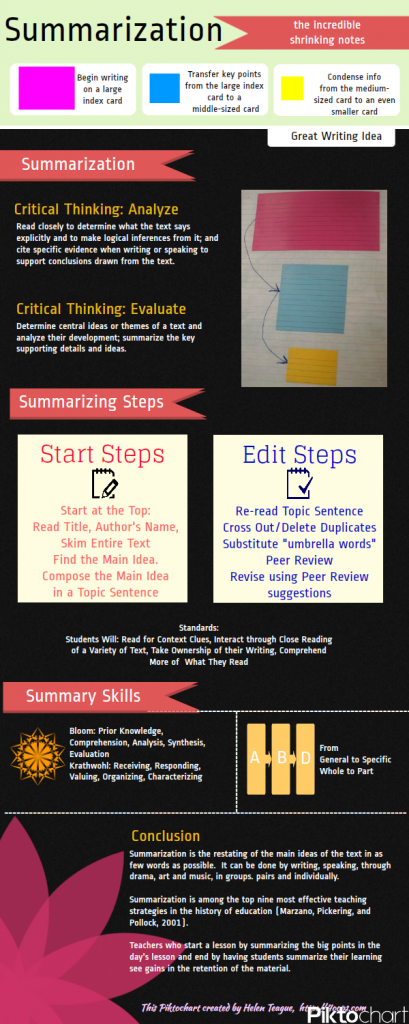Category: Uncategorized
Tags: Curriculum Resources, ELA, ESL, Geography:, Health, Helen Teague, math, Physical Science., Picture Books, Psychology, Science, Scientific method, U.S. History, Weather
Picture Books Across the Curriculum Including Curriculum Topic Connections
(Feel free to copy and distribute)
Geography:
Chin-Lee, Cynthia. A is for Americas. Spainsh culture,language
Louie, Ai-Ling. Yeh-Shen: A Cinderella Story from China. Chinese culture, lanugage
Pricemen, Marjorie. How to Make an Apple Pie and See the World. Mapping skills
Government/Economics
Cronin, Doreen. Click, Clack, Moo: Cows That Type. Labor union, negotiation tactics
Health
Ahlberg, Janet. The Baby’s Catalogue. Family roles
Freymann,Saxton. How are you Peeling? : Foods with moods. Emotions
Home Arts
Ahlberg, Janet. The Baby’s Catalogue. Family roles
Pricemen, Marjorie. How to Make an Apple Pie and See the World. Recipes, ingredients
Language Arts
Atwood, Margaret, 1939-. Princess Prunella and the Purple Peanut. Alliteration
Briggs, Raymond. Snowman. Creative writing
Cronin, Doreen. Click, Clack, Moo: Cows That Type. Personification
Day, Alexandra. Good Dog, Carl. Creative writing
Howe, James. I Wish I Were a Butterfly. Theme
Innocenti, Roberto. Rose Blanche. Foreshadowing
Martin, Bill. The Ghost-eye Tree. Tone
McKissack, Patricia. Mirandy and Brother Wind. Personification, onomatopoeia
Minters, Frances. Sleepless Beauty. Fractured fairy tale
Pilkey, Dave. Kat Kong: Starring Flash, Rabies, and Dwayne and Introducing Blueberry as the Monster. Pun, onomatopoeia
Polacco, Patricia. Just Plain Fancy. Pun, foreshadowing
Nickle, John. The Ant Bully. Theme
Ringgold, Faith. The Invisible Princess. Allusion
Rosenberg, Liz. Monster Mama. Theme
Say, Allen. Grandfather’s Journey. Simile,methaphor,foreshadowing
Schroeder, Alan. Smoky Mountain Rose: An Appalachian Cinderella. Regional history
Scieszka, Jon. The Stinky Cheese Man. Fractured fairy tale
Scieszka, Jon. The True Story of the Three Little Pigs. Point of view
Stevenson, Robert Louis, 1850-1894. A Child’s Garden of Verses. Poetry
Turkle, Brinton. Deep in the Forest. Point of View
Math
Birch, David. The King’s Chessboard. Number Patterns
Clement, Rod. Counting on Frank. Metric measurement
Friedman, Aileen. The King’s Commissioners. Place Value
Leedy, Loreen. Fraction Action. Fractions
Mahy, Margaret. 17 Kings and 42 Elephants. Division
Schwartz, David M. G is for Googol: A Math Alphabet Book. Math terms
Schwartz, David M. If You Made a Million. Finance
Tompert, Ann. Grandfather Tang’s Story. Geometry
Music
Chocolate, Debbi. The Piano Man. Vaudeville music
London, Jonathan. Hip Cat. Jazz
Moss, Lloyd. Zin!zin!zin! : A Violin. Musical instruments
Winter, Jeanette. Follow the Drinking Gourd. Underground Railroad
Psychology
Freymann,Saxton. How are you Peeling? : Foods with Moods. Emotions
Liersch, Anne. A House is not a Home. Relationships
Lionni, Leo, 1910-. Swimmy. Relationships, self-esteem
Porter-Gaylord, Laurel. I Love My Daddy Because… Family roles, relationships
Porter-Gaylord, Laurel. I Love My Mommy Because…Family roles, relationships
Ross, Tom. Eggbert, the Slightly Cracked Egg. Relationships, self-esteem
Sendak, Maurice. Where the Wild Things Are. Dreams
Science Earth Science
Baylor, Byrd. Everybody Needs a Rock. Geology
Kathryn Lasky. Science Fair Bunnies. Scientific method
Tresselt, Alvin R. White Snow, Bright Snow.Weatherz
Environmental Sciences
Briggs, Raymond. When the Wind Blows. Nuclear effects
Cherry, Lynne. The Great Kapok Tree: A Tale of the Amazon Rainforest. Conservation
Life Science
Cherry, Lynne. The Armadillo from Amarillo. Plant, animal life, regional animals
Eichenberg, Fritz, 1901-. Ape in a Cape: An Alphabet of Odd Animals. Zoology,taxonomy
Kathryn Lasky. Science Fair Bunnies. Scientific method
Lionni, Leo, 1910-. Swimmy. Mimicry
Ross, Tom. Eggbert, the Slightly Cracked Egg. Camouflage
Schwartz, David M. If You Hopped Like a Frog. Animal physiology
Physical Science
Briggs, Raymond. When the Wind Blows. Nuclear effects
Kathryn Lasky. Science Fair Bunnies. Scientific method
Spanish
Chin-Lee, Cynthia. A is for Americas. Vocabulary,culture
Technology
Munsch, Robert N. Jonathan Cleaned Up His Room —Then He Heard a Noise. Computer error effects
US History
Eve Bunting. The Wall. Vietnam Memorial
Innocenti, Roberto. Rose Blanche. World War II in Germany
Mochizuki, Ken. Baseball Saved Us. Japanese internment camps
Polacco, Patricia. Just Plain Fancy. Amish culture
Polacco, Patricia. Pink and Say. Civil War
Say, Allen. Grandfather’s Journey. Immigration
Seuss, Dr. The Butter Battle Book. War
Uchida, Yoshiko. The Bracelet .Japanese internment camps
Winter, Jeanette. Follow the Drinking Gourd. Song about Underground Railroad, African-American history







